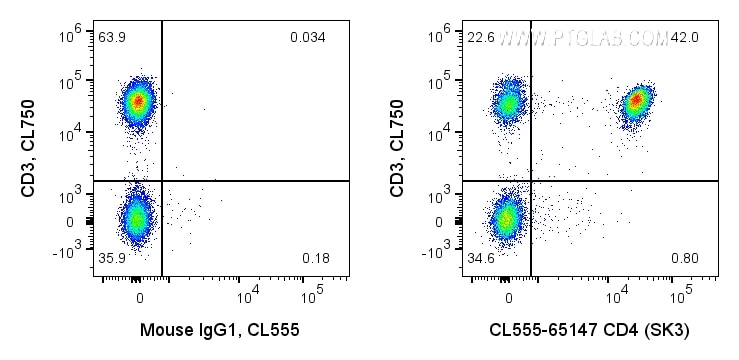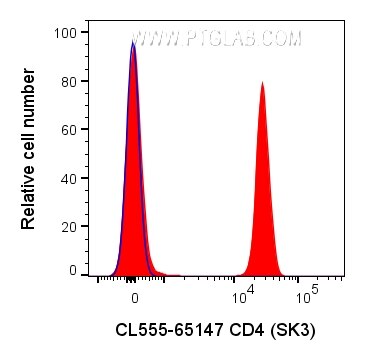Anticorps Monoclonal anti-CD4
CD4 Monoclonal Antibody for FC
Hôte / Isotype
Mouse / IgG1, kappa
Réactivité testée
Humain
Applications
FC
Conjugaison
CoraLite® Plus 555 Fluorescent Dye
CloneNo.
SK3
N° de cat : CL555-65147
Synonymes
Galerie de données de validation
Applications testées
| Résultats positifs en cytométrie | CMSP humaines, |
Dilution recommandée
| Application | Dilution |
|---|---|
| This reagent has been pre-titrated and tested for flow cytometric analysis. The suggested use of this reagent is 5 μl per 10^6 cells in a 100 µl suspension or 5 μl per 100 µl of whole blood. | |
| Sample-dependent, check data in validation data gallery | |
Informations sur le produit
CL555-65147 cible CD4 dans les applications de FC et montre une réactivité avec des échantillons Humain
| Réactivité | Humain |
| Hôte / Isotype | Mouse / IgG1, kappa |
| Clonalité | Monoclonal |
| Type | Anticorps |
| Immunogène | s/o |
| Nom complet | CD4 molecule |
| Masse moléculaire calculée | 55 kDa |
| Numéro d’acquisition GenBank | BC025782 |
| Symbole du gène | CD4 |
| Identification du gène (NCBI) | 920 |
| Conjugaison | CoraLite® Plus 555 Fluorescent Dye |
| Excitation/Emission maxima wavelengths | 554 nm / 570 nm |
| Forme | Liquide |
| Méthode de purification | Purification par affinité |
| Tampon de stockage | PBS with 0.09% sodium azide and 0.5% BSA. |
| Conditions de stockage | Store at 2-8°C. Avoid exposure to light. Stable for one year after shipment. |
Informations générales
CD4 is a 55-kDa transmembrane glycoprotein expressed on T helper cells, majority of thymocytes, monocytes, macrophages, and dendritic cells (PMID: 9304802; 12213222). CD4 is an accessory protein for MHC class-II antigen/T-cell receptor interaction. It plays an important role in T helper cell development and activation (PMID: 9539765; 3112582). CD4 serves as a receptor for the human immunodeficiency virus (HIV) (PMID: 9304802).
Protocole
| Product Specific Protocols | |
|---|---|
| FC protocol for CL Plus 555 CD4 antibody CL555-65147 | Download protocol |
| Standard Protocols | |
|---|---|
| Click here to view our Standard Protocols |



